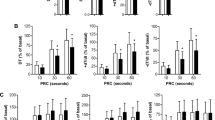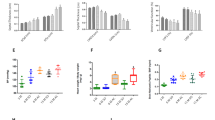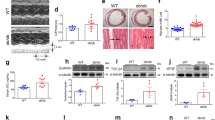Abstract
OBJECTIVE: To determine: 1) whether obesity predisposes the myocardium to oxidative stress as evidenced by higher tissue levels of myocardial lipid peroxidation, and 2) what cellular mechanisms are responsible for this predisposition.
DESIGN: Comparative, descriptive study of the myocardial tissue of lean and obese Fatty Zucker animals.
ANIMALS: 12 month old lean (−/fa; n=6; mean body weight=590 g) and obese (fa/fa; na=7; mean body weight=882 g) male Fatty Zucker rats.
MEASUREMENTS: Basal lipid peroxidation (assessed using thiobarbituric reactive acid substances (TBARS) and cumene hydroperoxide equivalents), oxidative and antioxidant enzyme activities (citrate synthase (CS), superoxide dismutase (SOD), glutathione peroxidase (GPX) and catalase (CAT), thiol content, heat shock protein expression (HSP72/73) and TBARS concentrations following an iron-mediated challenge in vitro.
RESULTS: Compared to lean, lipid peroxidation was greater (P<0.05) in the left ventricle (LV) from obese rats as indicated by higher levels of lipid hydroperoxides (mean=11.48 vs 13.7 cumene hydroperoxide equivalents (CHPE)/mg lipid) and TBARS (mean=11.1 vs 13.9 nMol/mg lipid.). The activity of the manganese isoform of superoxide dismutase in the LV was higher (P<0.05) in obese animals, compared to controls (mean=135 vs 117 U/mg protein). In contrast, LV catalase and glutathione peroxidase activities did not differ (P>0.05) between groups. Also, LV levels of HSP 72 (inducible) and 73 (constitutive) did not differ (P>0.05)( between lean and obese animals. Following an iron-stimulated oxidative challenge in vitro, TBARS concentration was significantly greater (P<0.05) in LV of obese rats compared to the lean (mean=12.7 vs 16.7 nMol/mg lipid).
CONCLUSIONS: These results support the notion that obesity predisposes the myocardium to oxidative stress. However, the postulate that obesity is associated with elevated myocardial antioxidant enzyme activities and HSPs was only partially supported by these findings.
This is a preview of subscription content, access via your institution
Access options
Subscribe to this journal
Receive 12 print issues and online access
$259.00 per year
only $21.58 per issue
Buy this article
- Purchase on Springer Link
- Instant access to full article PDF
Prices may be subject to local taxes which are calculated during checkout
Similar content being viewed by others
Author information
Authors and Affiliations
Rights and permissions
About this article
Cite this article
Vincent, H., Powers, S., Stewart, D. et al. Obesity is associated with increased myocardial oxidative stress. Int J Obes 23, 67–74 (1999). https://doi.org/10.1038/sj.ijo.0800761
Received:
Revised:
Accepted:
Published:
Issue Date:
DOI: https://doi.org/10.1038/sj.ijo.0800761
Keywords
This article is cited by
-
The role of carbohydrate counting in glycemic control and oxidative stress in patients with type 1 diabetes mellitus (T1DM)
Hormones (2020)
-
Very low calorie diets are associated with transient ventricular impairment before reversal of diastolic dysfunction in obesity
International Journal of Obesity (2019)
-
Assessment of Atrial Electromechanical Delay by Tissue Doppler Echocardiography in Obese Subjects
Obesity (2011)
-
Exercise-induced oxidative stress in overweight adolescent girls: roles of basal insulin resistance and inflammation and oxygen overconsumption
International Journal of Obesity (2009)
-
Oxidative Stress in Severely Obese Persons Is Greater in Those With Insulin Resistance
Obesity (2009)



